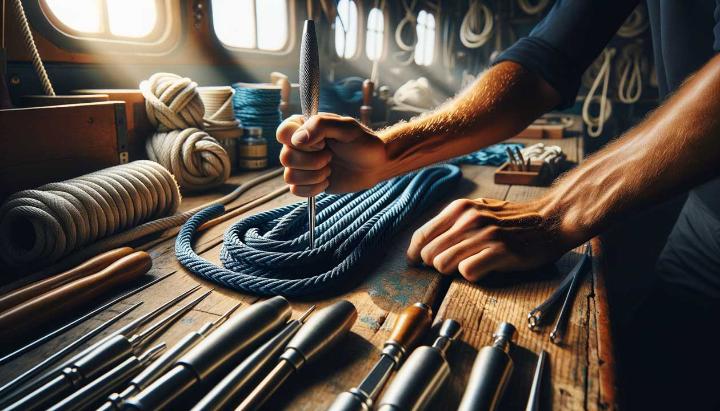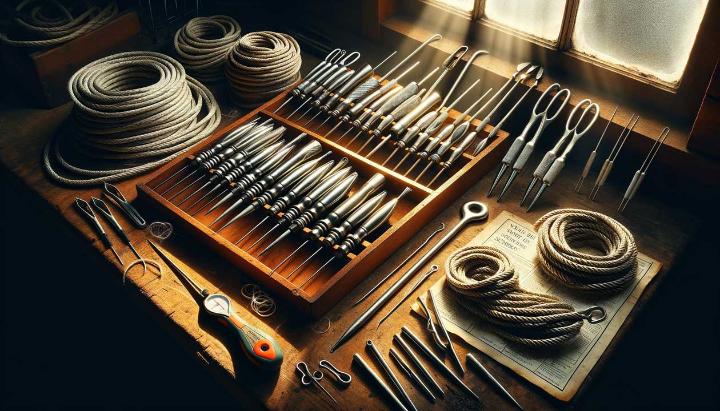Have you ever found yourself in a tangle with rope splicing? Whether you're a seasoned sailor or a DIY enthusiast, mastering the art of splicing can be a game-changer. But here's the kicker: without the right tools, even the simplest splice can turn into a frustrating ordeal. That's where iRopes steps in, revolutionising the way we approach rope work.
Imagine having a set of tools so precise, they make splicing feel like second nature. iRopes doesn't just offer splice tools; they provide a gateway to perfection in rope craftsmanship. From their top-notch fid tools to their innovative splice tool designs, iRopes is changing the game for rope enthusiasts worldwide.
In this guide, we'll unravel the secrets of mastering your fid tool rope, exploring essential splice tool tips that will elevate your skills from amateur to expert. But that's not all - we'll also delve into iRopes' comprehensive range of products, including their premium winch ropes, tow ropes, and shackles. Get ready to discover why iRopes is the go-to choice for professionals and hobbyists alike when it comes to all things rope-related.
Understanding the Basics of Fid Tool Rope Splicing
Have you ever marvelled at the intricate knots and splices on a sailboat or wondered how those sturdy rope loops are created? Welcome to the fascinating world of rope splicing! As an avid sailor and rope enthusiast, I've spent countless hours perfecting this essential skill, and I'm excited to share my knowledge with you.
What is a Rope Splicing Fid?
A rope splicing fid is a sailor's best friend when it comes to creating strong, reliable rope connections. Imagine a sleek, tapered tool that looks like a cross between a needle and a small sword. That's your fid! It's designed to separate rope strands and guide them through the splice, making what was once a daunting task accessible to both novices and experts alike.

Types of Rope Splices
In my years of experience, I've encountered three main types of splices that every rope enthusiast should know:
- Eye splice: Creates a permanent loop at the end of a rope, perfect for mooring lines or creating a secure attachment point.
- Back splice: Prevents rope ends from fraying, ideal for finishing off cut ropes neatly.
- Short splice: Joins two ropes together, maintaining nearly full strength of the original rope.
Each splice has its unique purpose and technique, but with practice, you'll find yourself confidently tackling all three.
Choosing the Right Fid Size
Selecting the correct fid size is crucial for a successful splice. Here's a tip I learned the hard way: the fid length should typically be about 21 times the diameter of your rope. For example, if you're working with a 10mm rope, you'll want a fid around 210mm long.
Pro tip: Keep a range of fid sizes in your toolkit to accommodate different rope diameters. Trust me, it'll save you time and frustration in the long run!
Remember, mastering the art of rope splicing takes time and patience. But with the right tools and techniques, you'll be creating professional-looking splices in no time. So, are you ready to give it a go? Grab your fid, choose your rope, and let's start splicing!
Essential Splice Tool Tips for Successful Splicing
As a seasoned rope enthusiast, I've learned that mastering the art of splicing is all about having the right tools and techniques. Let's dive into some essential tips that'll help you create flawless splices every time.
Choosing the Right Size and Type of Splice Tool
Selecting the perfect splice tool can make or break your splicing project. Here's what I've discovered through years of trial and error:
- Size matters: Always match your fid tool to your rope diameter. A good rule of thumb is to choose a fid that's about 21 times the rope's diameter.
- Material matters too: For synthetic ropes, I prefer stainless steel fids for their durability and smooth surface. For natural fibres, wooden fids can be gentler on the rope.
- Consider versatility: Some modern fids come with interchangeable tips, allowing you to work with various rope sizes using a single tool.
Preparing the Rope Ends for Splicing
Proper preparation is the key to a clean, strong splice. Here's my go-to process:
- Measure and mark your splice length carefully.
- Secure the rope to prevent unravelling during splicing.
- If working with synthetic rope, use heat to seal the cut ends and prevent fraying.
- Gently unlay the strands, keeping them organised for easy re-weaving.
Pro tip: Always work in a well-lit area and use a magnifying glass for intricate work, especially with smaller diameter ropes. Your eyes will thank you!
Step-by-Step Guide to Using a Fid Tool for Splicing
Now, let's walk through the splicing process:
- Insert the fid into the rope at your marked point, following the rope's natural lay.
- Gently work the fid through the rope, creating a tunnel for the strand you'll be splicing.
- Thread the strand through the fid's eye and pull it through the tunnel you've created.
- Repeat this process for each strand, following your specific splice pattern.
- Once all strands are in place, gently work the splice to settle the strands and even out the tension.
Remember, patience is key. Don't rush the process - a well-executed splice is worth the time invested.
Common Mistakes to Avoid When Using a Splice Tool
Even experienced splicers can fall into these traps. Here are some pitfalls to watch out for:
- Forcing the fid: If you're meeting resistance, stop and reassess. Forcing the fid can damage the rope's core.
- Inconsistent tension: Ensure each strand is pulled through with equal tension to maintain the rope's strength and appearance.
- Neglecting the finish: Don't forget to properly finish your splice by tapering the ends and securing any loose strands.
- Ignoring rope construction: Different rope types (braided, twisted, etc.) require different splicing techniques. Always research the specific method for your rope type.
By avoiding these common mistakes and following the tips we've discussed, you'll be well on your way to creating professional-quality splices. Remember, practice makes perfect, so don't get discouraged if your first attempts aren't flawless. Keep at it, and soon you'll be splicing like a pro!

Mastering Advanced Fid Tool Techniques
As we dive deeper into the art of rope splicing, it's time to explore some advanced techniques that will elevate your skills to the next level. Whether you're a seasoned sailor or an enthusiastic DIY-er, mastering these methods will open up a world of possibilities for your rope projects.
Creating Eye Splices with a Fid Tool
Eye splices are one of the most versatile and useful splices you can create. They form a permanent loop at the end of a rope, perfect for mooring lines or creating secure attachment points. Here's how to craft a professional-looking eye splice:
- Measure and mark your desired loop size, adding extra length for the splice (typically 3-5 times the rope diameter).
- Unlay the rope strands carefully, keeping them in order.
- Insert the fid tool into the rope at your marked point, following the lay of the rope.
- Thread each strand through the rope core, following a specific pattern based on your rope type.
- Taper the splice by gradually reducing the number of passes for each strand.
- Finish by rolling the splice under your palm to smooth it out.

Splicing Different Types of Rope Materials
Different rope materials require unique approaches to splicing. Here's a quick guide to help you navigate various rope types:
- Braided ropes: These ropes have a smooth, round appearance and are typically made from synthetic fibres. They require a fid to open up the core for splicing.
- Three-strand ropes: Common in natural fibres like cotton or manila, these ropes are spliced by unlaying the strands and weaving them back together.
- Double-braided ropes: These high-strength ropes have an inner core and outer sheath, requiring a more complex splicing technique involving both components.
Maintaining and Caring for Your Fid Tool Rope
Proper maintenance of your splicing tools and ropes is crucial for longevity and performance. Follow these tips to keep your equipment in top shape:
- Clean your fid tools: After each use, wipe down your fids with a clean cloth to remove any dirt or debris.
- Store properly: Keep your fids in a dry place, preferably in a protective case to prevent damage.
- Inspect regularly: Check your fids for any signs of wear or damage before each use.
- Care for your ropes: Rinse ropes with fresh water after use in saltwater, and store them coiled in a cool, dry place away from direct sunlight.
Troubleshooting Common Issues During Splicing
Even experienced splicers encounter challenges. Here are some common issues and how to address them:
Uneven splice: If your splice looks lumpy or uneven, try re-tensioning the strands and rolling the splice under your palm to smooth it out.
Difficulty inserting the fid: If you're struggling to insert the fid, ensure you're following the rope's natural lay. Sometimes, gently twisting the rope can help open up the structure.
Fraying ends: To prevent fraying, use heat-shrink tubing or whipping twine to secure the ends of synthetic ropes after splicing.
Remember, mastering these advanced techniques takes practice and patience. Don't get discouraged if your first attempts aren't perfect. With time and experience, you'll be creating flawless splices that stand up to the toughest conditions. Keep honing your skills, and soon you'll be splicing like a seasoned pro!
Comprehensive Rope Splicing Solutions
As a seasoned sailor and rope enthusiast, I've had the pleasure of working with countless splicing tools over the years. But I must say, iRopes' comprehensive range of splicing solutions has truly impressed me. Let me take you through their offerings and explain why they stand out in the world of rope splicing.
Range of High-Quality Splicing Tools
iRopes doesn't just offer run-of-the-mill splicing tools; they provide a carefully curated selection that caters to every splicing need imaginable. From precision-engineered fids to specialized needles, their product range covers it all:
- Fid sets: Available in various sizes to accommodate different rope diameters, these sets are a splicing enthusiast's dream.
- Hollow fids: Perfect for working with hollow-braid ropes, these tools make core-to-core splicing a breeze.
- Splicing needles: Ideal for delicate work on smaller diameter ropes or when creating intricate decorative splices.
- Splice measuring tools: Ensure precise measurements for consistent, professional-looking splices every time.

Customization Options for Fid Tools
What sets iRopes apart is their commitment to meeting the unique needs of their customers. They offer customization options that I haven't seen anywhere else in the industry:
- Material selection: Choose from stainless steel, aluminum, or even specialized polymer fids for specific rope types.
- Size customization: Need a fid that's not in the standard range? iRopes can create custom sizes to fit your exact specifications.
- Grip enhancements: For those long splicing sessions, ergonomic grip options can be added to reduce hand fatigue.
- Branding options: Perfect for professional riggers or sailing schools, iRopes offers custom branding on their splicing tools.
Expert Guidance and Support
What truly elevates iRopes' offering is their team of splicing professionals. These aren't just salespeople; they're experienced riggers and sailors who understand the intricacies of rope work. Their support includes:
- Personalized consultations: Get expert advice on choosing the right tools for your specific splicing projects.
- Video tutorials: Access a library of detailed instructional videos covering various splicing techniques.
- Workshops and training: For those looking to deepen their skills, iRopes offers hands-on splicing workshops.
- Troubleshooting assistance: Stuck on a tricky splice? Their team is just a call away to help you through it.
Pro tip: Take advantage of iRopes' expert consultations before starting a complex splicing project. Their insights have saved me countless hours of trial and error!
Advantages of Choosing iRopes
After years of working with various suppliers, here's why I believe iRopes stands out:
- Quality assurance: Each tool undergoes rigorous testing to ensure it meets iRopes' high standards.
- Innovative designs: They're constantly refining their tools based on user feedback and emerging rope technologies.
- Comprehensive solutions: From basic fids to advanced splicing kits, they've got everything you need in one place.
- Exceptional customer service: Their responsive and knowledgeable support team is truly unmatched in the industry.
Whether you're a novice just starting your splicing journey or a seasoned professional looking for top-notch tools, iRopes has something to offer. Their commitment to quality, customization, and customer support makes them my go-to recommendation for all things splicing. Why not give them a try on your next project? You might just find, as I did, that the right tools make all the difference in creating perfect splices every time.
Mastering the fid tool rope splicing techniques is essential for rope enthusiasts and professionals alike. This blog post delves into understanding the fid tool, selecting the right splice tool, and avoiding common mistakes. Learn advanced techniques like creating eye splices and working with different rope materials. Discover iRopes' comprehensive range of high-quality splicing tools and expert guidance, offering customisable solutions for every need. Enhance your splicing skills and rely on iRopes for top-tier splice tool solutions.
Get Expert Guidance with Our Inquiry Form
Fill in the form above to connect with our team for personalised advice on choosing and using the perfect splice tool and fid tool for your projects. iRopes is here to support you every step of the way.